ISSN ONLINE(2319-8753)PRINT(2347-6710)
ISSN ONLINE(2319-8753)PRINT(2347-6710)
S.Kailainathan1, S.Kalyana Sundaram2, K.Nijanthan1
|
| Related article at Pubmed, Scholar Google |
Visit for more related articles at International Journal of Innovative Research in Science, Engineering and Technology
Friction stir welding (FSW) is a technique in which the work pieces were joined by means of frictional heating and plastic deformation typically at temperatures below the melting temperature of the materials to be joined. The scope of this investigation is to evaluate the effect of joining parameters on the mechanical properties of dissimilar aluminium alloys (AA6063 and AA8011 aluminium alloy) joints produced using friction stir welding. Friction stir weld was performed on the dissimilar aluminium alloys using different rotational speeds and traverse speeds and the influence of these parameters on the mechanical performance of the weld has been investigated in terms of hardness and tensile testing.
Keywords |
| Aluminium alloys, Friction stir welding, Hardness, Tensile strength |
I. INTRODUCTION |
| Aluminium alloys find wide applications in aerospace, automobile industries, railway vehicles, bridges, offshore structure topsides and high speed ships due to its light weight and higher strength to weight ratio [1-3]. Friction stir welding (FSW) is an innovative solid phase welding process in which the metal to be welded is not melted during welding, thus the cracking and porosity often associated with fusion welding processes are eliminated [4&5]. Therefore, the FSW process can also be used to weld aluminium alloys in order to obtain high quality joints. However the mechanical properties of the friction-stir-welded joints have indicated the softening in the joints of the aluminium alloys such as AA6063 and AA8011 caused due to dissolution or growth of strengthening precipitates during the welding thermal cycle, thus resulting in the degradation of mechanical properties of the FSW joints [6]. The welding parameters namely rotational speed and traverse speed were considered as the prominent factors which affects the mechanical performance of the welding [7-9]. This work is focused on studying the influence of rotational speed and traverse speed on the mechanical properties of FSW joints carried out in AA6063 and AA8011aluminium alloys. |
II. MATERIALS AND METHODS |
| A. Materials |
| The dissimilar material aluminium alloys 6063 and 8011 were used in this investigation. High carbon high chromium oil hardening steel was used as tool material. Chemical compositions of the alloy material are given in the Table.1. The dissimilar aluminium alloys used in this investigation was welded using Friction stir welding technique. |
 |
| B. Fabrication Method |
| The rolled plates of 6mm thickness AA6063 and AA8011 aluminium alloys were cut into required sizes (100 x 50 mm) using power hacksaw. A square but joint configuration was prepared to carry out the FSW joints. The initial joint configuration was obtained by securing the plates in position using mechanical clamps. The direction of welding was normal to the rolling direction .Non consumable tool made up of chromium high carbon steel was used for joining process. The aluminium alloys were joined by varying rotational speed in four levels namely 800,1000,1200 and 1400 rpm and traverse speed in three levels namely 50,60 and 70 mm/min as shown in the Figure.1 |
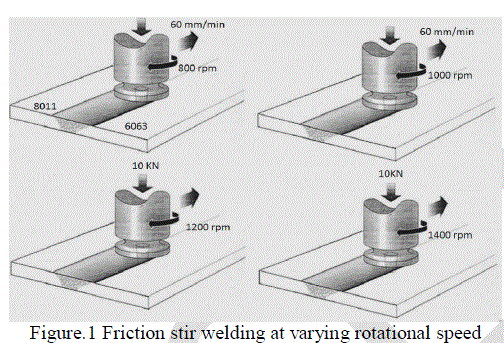 |
| The tool used for fabricating the joints is made by high carbon steel of diameter 20 mm with shoulder diameter as 12mm and with a cylindrical pin of diameter 5mm. With the identified process parameters the joints were fabricated. |
| C. Mechanical Testing |
| Tensile test and hardness tests have been carried out on the welded plate using ASTM E8M-11 and ASTM E384 standard respectively. The tensile load was applied on the welded joint using Instron testing machine and Wilson Brinell hardness testers was used for performing harness test on the welded region. For each welded plate a set of 3 samples were subjected to tensile and hardness test and the average value has been calculated. The welded specimens prepared for tensile and hardness test are shown in the Figure.2 and Figure.3 respectively. |
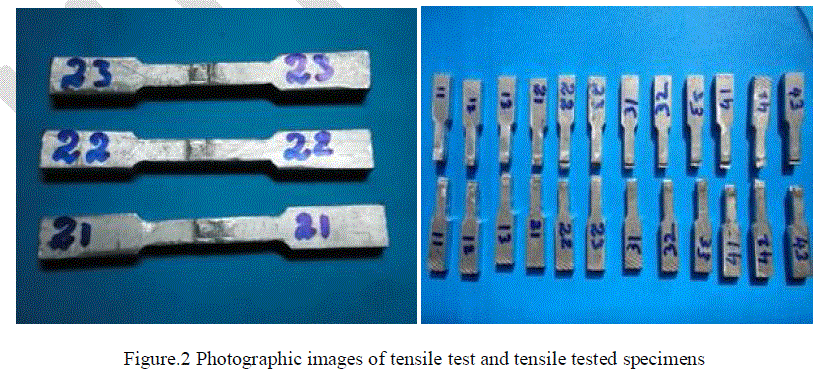 |
| The hardness test was carried out in the welded specimen at five different welded location and the average value has been calculated in terms of BHN as per ASTM standard. |
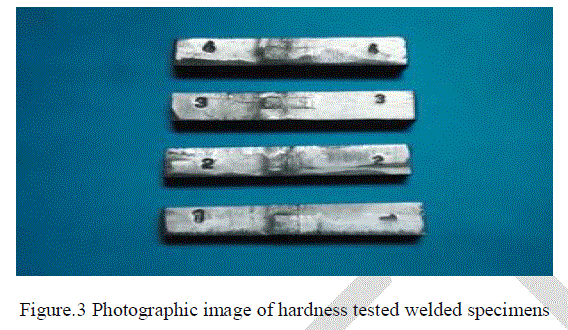 |
| D. SEM Analysis |
| The distribution of elements on the joint interface was examined using a scanning electron microscope (SEM) Samples were first dipped in a polishing solution containing 55ml orthophosporic acid, 25ml acetic acid and 20 ml nitric acid heated to 70 °C. Then the polished sample were washed in water and then etched with a solution containing 100 ml water, 50 ml hydrochloric acid and 5gm ferric chloride. The sample preparation adopted in this technique helped in obtaining SEM images with better clarity. |
II. RESULTS AND DISCUSSION |
| A. Tensile properties of the welded specimen |
| The tensile strength of the welded specimen was measured as per ASTM E8M-11 standard. A total of twelve specimens, welded at varying rotational speed and transfer speed were prepared and tested. The experimental values obtained from the tensile testing of the welded specimens were shown in the Figure.4. The tensile strength of the specimen was found to better with weld made at a transfer speed of 60 mm/min and at the same time there was a increase in tensile strength with the increase in rotational speed this may be due to the uniform temperature distribution offered by tool at the weld region. But an adverse effect was seen when the rotational speed is increased beyond 1200 rpm. This is due to the distortion found at the welded region which is caused at higher rotational speed. The better value of tensile strength of 134 MPa was obtained at rotational and transfer speed of 1200 rpm and 60mm/min respectively. |
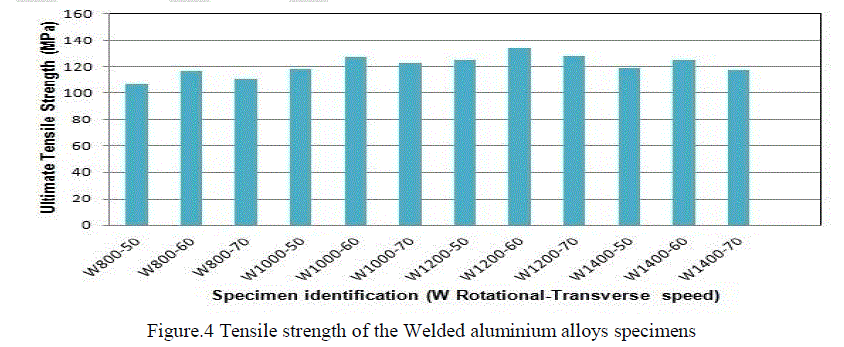 |
| B. Hardness properties of the welded specimen |
| The hardness of the welded specimen was measured using Brinell hardness scale. A total of twelve specimens, welded at varying rotational speed and transfer speed were prepared and tested. The hardness was determined at five various position of weld in the sample and the average value was calculated. The experimental values obtained from the hardness testing of the welded specimens were shown in the Figure.5. The hardness of the specimen was found to increase with the increase in rotational speed and transverse speed and reached a maximum of 18 BHN at a rotational and transverse speed of 1000 rpm and 70 mm/min respectively. The increase in rotational speed beyond this critical limit resulted in decrease in hardness. |
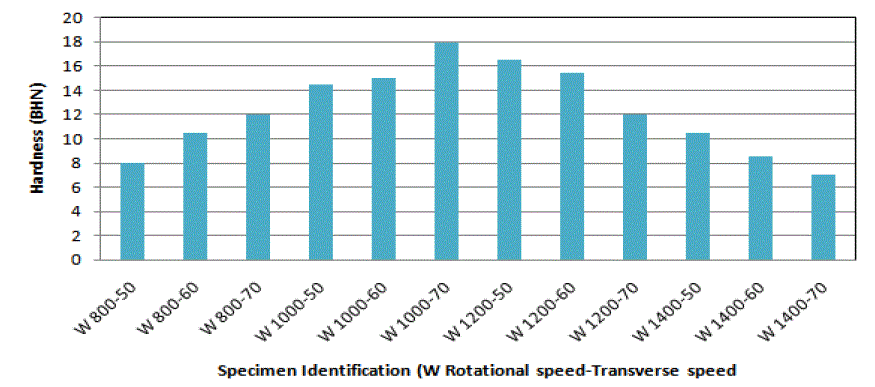 |
| C. SEM investigation on the welded specimen |
| The SEM image welded specimen which resulted in better tensile strength is shown in the Figure.6. The minute laceration found on the welded region confirms the effective weld carried out at the better welding condition i.e. rotational and transverse speed of 1000 rpm and 60 mm/min respectively. The SEM image also revealed the tight packing of aluminium alloys due to the perfect friction offered by the welding parameters on the welded region. |
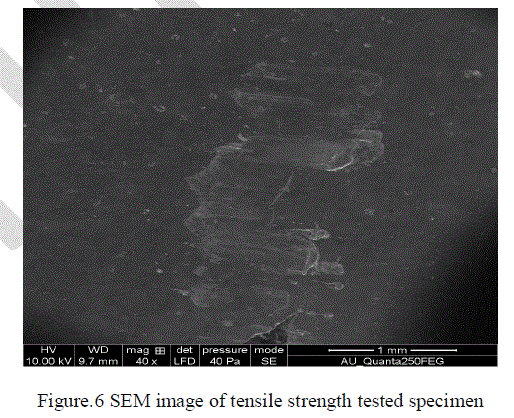 |
IV CONCLUSION |
| Aluminium alloys were widely used in aerospace and ship building areas. Welding is one of the main joining processes used in those areas. 8 series aluminium have high strength compare to other aluminium alloys. The welding parameter considered in this investigation was found to greatly influence the tensile and hardness properties of dissimilar aluminium alloys weld. Therefore welding process in 8 series of aluminium is able to improve its application areas. Friction stir welding on other series like 9 series aluminium welding will improve the strength of the products higher than 8 series aluminium. This will open the gate for the further researchers. |
References |
|